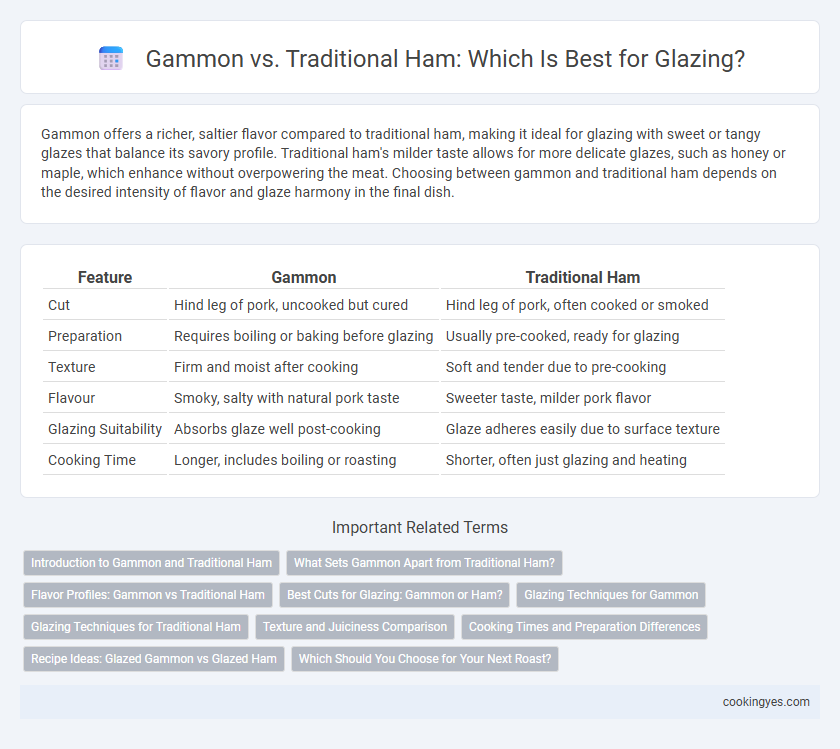Gammon offers a richer, saltier flavor compared to traditional ham, making it ideal for glazing with sweet or tangy glazes that balance its savory profile. Traditional ham's milder taste allows for more delicate glazes, such as honey or maple, which enhance without overpowering the meat. Choosing between gammon and traditional ham depends on the desired intensity of flavor and glaze harmony in the final dish.
Table of Comparison
| Feature | Gammon | Traditional Ham |
|---|---|---|
| Cut | Hind leg of pork, uncooked but cured | Hind leg of pork, often cooked or smoked |
| Preparation | Requires boiling or baking before glazing | Usually pre-cooked, ready for glazing |
| Texture | Firm and moist after cooking | Soft and tender due to pre-cooking |
| Flavour | Smoky, salty with natural pork taste | Sweeter taste, milder pork flavor |
| Glazing Suitability | Absorbs glaze well post-cooking | Glaze adheres easily due to surface texture |
| Cooking Time | Longer, includes boiling or roasting | Shorter, often just glazing and heating |
Introduction to Gammon and Traditional Ham
Gammon, a cured hind leg of pork similar to traditional ham, is often used interchangeably in glazing recipes but differs in preparation and flavor profile. Traditional ham is typically cooked and may be wet-cured or dry-cured, presenting a saltier and denser texture, while gammon is raw and requires cooking, offering slightly sweeter and more tender meat. Understanding these distinctions is crucial for selecting the best option for glazing techniques to achieve optimal taste and texture.
What Sets Gammon Apart from Traditional Ham?
Gammon differs from traditional ham primarily in its curing process, as it is prepared from the hind leg of pork and typically dry-salted or brined before being smoked or cooked, resulting in a distinct texture and flavor. Unlike traditional ham, which is often wet-cured or boiled, gammon has a firmer texture and a saltier, more intense taste that pairs exceptionally well with sweet glazes like honey or mustard. This characteristic makes gammon ideal for glazing, enhancing its savory profile while providing a balanced contrast that accentuates both the meat and the glaze's sweetness.
Flavor Profiles: Gammon vs Traditional Ham
Gammon offers a richer, saltier flavor profile with a slightly smoky undertone compared to the sweeter, milder taste of traditional ham, making it ideal for robust glazing ingredients like mustard and brown sugar. Traditional ham tends to absorb glazes more uniformly due to its leaner texture, enhancing subtle sweet or tangy notes from honey or fruit-based glazes. The choice between gammon and traditional ham significantly impacts the final flavor complexity and balance of savory and sweet elements in the glazed dish.
Best Cuts for Glazing: Gammon or Ham?
Gammon, cured but usually unsmoked, offers a fattier texture that absorbs glazes better, creating a rich, flavorful crust during cooking. Traditional ham, often smoked and fully cooked, provides a firmer cut that holds shape but may resist glazing penetration compared to gammon. For optimal glazing results, selecting gammon is preferable due to its balance of fat and meat, enhancing both taste and glaze adherence.
Glazing Techniques for Gammon
Gammon requires specific glazing techniques to enhance its rich, salty flavor and tender texture, often involving a blend of sweet and spicy ingredients like honey, mustard, cloves, and brown sugar. Unlike traditional ham, which may be pre-glazed or cured differently, gammon benefits from a slower baking process where the glaze is applied multiple times toward the end of cooking to create a caramelized, sticky crust. Optimal glazing for gammon involves scoring the fat layer to allow the glaze to penetrate deeper, intensifying both taste and visual appeal.
Glazing Techniques for Traditional Ham
Traditional ham glazing involves applying a sweet and savory mixture, often consisting of ingredients like honey, brown sugar, mustard, and cloves, which caramelize during roasting to create a glossy, flavorful crust. The glaze is typically brushed on multiple times throughout the cooking process to ensure deep penetration and a rich, sticky finish. This technique contrasts with Gammon glazing, where simpler, less frequent applications are common, resulting in a milder surface flavor.
Texture and Juiciness Comparison
Gammon offers a slightly firmer texture compared to traditional ham, which tends to be softer due to its curing process. In terms of juiciness, gammon retains more moisture when glazed, resulting in a succulent bite, while traditional ham may lose some juiciness but delivers a delicate, melt-in-the-mouth experience. The choice between the two depends on whether a chewier texture or a tender, juicy finish is preferred for glazing.
Cooking Times and Preparation Differences
Gammon requires longer cooking times than traditional ham due to its raw, cured nature, often needing several hours to fully cook through. Preparation for gammon typically involves soaking or boiling before glazing to remove excess salt, whereas traditional ham, usually pre-cooked or smoked, can be glazed and heated directly. These differences influence texture and flavor development during glazing, with gammon producing a tender, richly flavored finish compared to the quicker, milder preparation of traditional ham.
Recipe Ideas: Glazed Gammon vs Glazed Ham
Glazed gammon offers a slightly saltier and meatier flavor compared to traditional ham, making it ideal for robust glazes such as mustard and brown sugar or pineapple and clove combinations. Traditional ham, often cured and less salty, pairs well with sweet glazes like honey and maple or apricot preserves that enhance its subtler taste. Both cuts benefit from scoring the surface to allow glaze penetration, ensuring a caramelized and flavorful finish.
Which Should You Choose for Your Next Roast?
Gammon offers a saltier, more intense flavor and is often pre-cooked, making it ideal for glazing and roasting with bold, sweet glazes. Traditional ham provides a milder, subtly smoky taste with a tender texture that pairs well with delicate honey or mustard glazes. Choosing between gammon and traditional ham depends on your desired flavor profile and glazing style for your next roast.
Gammon vs traditional ham for glazing Infographic

 cookingyes.com
cookingyes.com